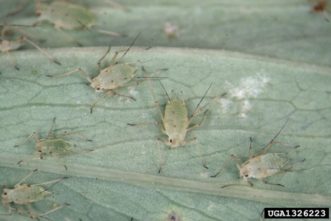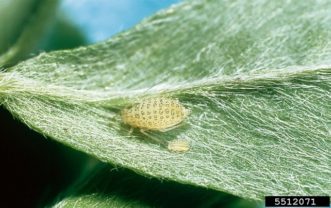This publication provides information about important insect pests of alfalfa in South Carolina and surrounding states in the southeastern United States. Descriptions of the insect pests, scouting procedures, and management recommendations are presented. This information will be useful to producers of alfalfa or anyone, such as crop consultants, examining and managing the crop regularly during the growing season when insects are important.
Introduction
Although alfalfa, Medicago sativa L., supports a diverse fauna of arthropod species in the southeastern United States, most of the insects found in the leguminous forage crop are not yield-limiting pests and can be classified as 1) incidental herbivores or transient species, not causing significant plant injury, 2) natural enemies, feeding on other insects as parasitoids or predators, or 3) pollinators, providing pollination services in the landscape. However, some of the species present in alfalfa can cause significant injury to the crop and are classified as pests. Of these pest species, only a few regularly reach high levels and are economically important. Pest managers should scout alfalfa frequently for pest species and manage them using strategies of integrated pest management (IPM).1 Integrated pest management strategies include, but are not limited to, cultural control (the use of agronomic practices to reduce insect numbers or injury),2 biological control (conserving, augmenting, or manipulating natural enemies of insect pests),3,4 mechanical/physical control (using barriers, traps, etc.),5 or chemical control (insecticides used at defined thresholds).6 The optimal IPM approach uses cultural, biological, and other control tactics before relying on chemical control, ideally, as the last resort. No matter what strategies are used, scouting for insect pests or injury to plants is always an early and essential step.
Scouting
Estimating populations of insect pests in alfalfa can be accomplished with several methods. The sweep-net method is the most common approach for determining levels of insects present in the crop.7 Sweep nets can be purchased from several online suppliers. The sweep-net method involves swinging a conical cloth net on a wire hoop attached to a handle through the crop in a sweeping motion, gathering arthropods in the bottom of the net for counting after a set number of sweeps. In a similar method, plants can be shaken over or into a pan or bucket to dislodge insects for counting. Alternatively, a pest manager could simply visually estimate numbers of arthropods or injury levels present when walking through the crop, as treatment thresholds for some pests are based on presence/absence. No matter what method of scouting is used, having “boots on the ground” is essential to knowing if problems with insects are present.
Important Insect Pests
Alfalfa can host numerous species of pestiferous insects, but proper scouting procedures will define those that meet or exceed treatment thresholds. Of these pestiferous insects, only a limited number are persistent pests. Some of the major insect pests that can consistently cause problems in alfalfa include (in no particular order)
- alfalfa weevil, Hypera postica (Gyllenhal)
- treehoppers and leafhoppers, such as threecornered alfalfa hopper, Spissistilus festinus (Say), and potato leafhopper, Empoasca fabae (Harris)
- various species of aphids (Hemiptera: Aphididae)
- blister beetles (Coleoptera: Meloidae)
- armyworms (Lepidoptera: Noctuidae), such as fall armyworm, Spodoptera frugiperda (J.E. Smith), and yellowstriped armyworm, Spodoptera ornithogalli
- grasshoppers (Orthoptera: Acrididae)
Other pest species can sometimes be present. Proper identification of species is important because the choice of insecticide should be based on the species present.
Alfalfa Weevil
The earliest reports of alfalfa weevil as a pest of alfalfa are from the early 1900s as an invasive species new to North America.8 Adults of the alfalfa weevil are small, light brown or grayish beetles about one-fourth inch in length with a darker stripe down the dorsum (top or “back”) (figure 1).
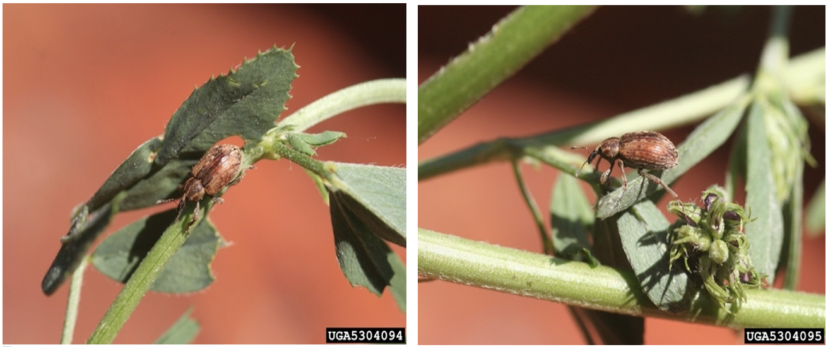
Figure 1. Alfalfa weevil adults. Image credit: Whitney Cranshaw, Colorado State University, Bugwood.org.

Figure 2. Alfalfa weevil larvae. Image credit: Clemson University/USDA Cooperative Extension Slide Series, Bugwood.org.
The mouthparts are chewing and located at the end of a “snout” (rostrum on the head), with eyes near the base and antennae near the tip. Adults can feed on foliage and cause defoliation, and females chew holes in the stems in which to lay eggs, but most injury is caused by the larval stage. Larvae (beetle grubs) of the alfalfa weevil are green and have a distinctive white line running down the dorsum (figure 2). Larvae can reach about three-eighths inch in length when fully developed. Larvae of alfalfa weevil can cause significant loss of leaf material and can require intervention with insecticides.
To scout for alfalfa weevils, thirty plants should be pulled from several locations throughout the field one to two times per week from mid-February through first cutting. The stems should then be placed upside down in a bucket and the plants beaten against the side to dislodge larvae with extra effort on cool days. Insecticides may be warranted to control alfalfa weevils when 0.5 larvae per stem are found for alfalfa between three to eight inches tall, one larva per stem for alfalfa between nine to fourteen inches tall, and 1.5 larvae per stem for alfalfa fifteen inches or taller. Alternatively, a threshold of twenty larvae per sweep can be used as a threshold for treatment with insecticide. These thresholds should be used in conjunction with an injury threshold of 30% of the scouted plants having damaged terminals.9 Scouts might also notice holes chewed in stems by females for oviposition.
Alfalfa weevils are also readily parasitized throughout North America by natural enemies.3 Many insecticides that would be applied for weevil control are also highly toxic to these beneficial insects, emphasizing the importance of using insecticides based on economic thresholds.
Threecornered Alfalfa Hopper
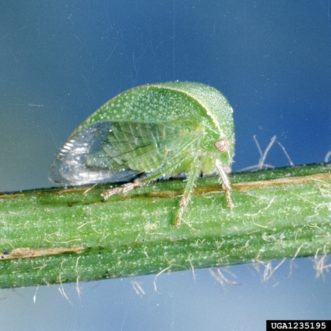
Figure 3. Threecornered alfalfa hopper adult. Image credit: Clemson University/USDA Cooperative Extension Slide Series, Bugwood.org.
Adults of the threecornered alfalfa hopper (TCAH) are green and about one-fourth inch in length (figure 3). They get their name from having three “corners” to their body shape in a triangular shield shape when viewed from directly overhead. Immature stages, called nymphs, are light green and have a curved and spiny dorsum. Both life stages of TCAH have piercing-sucking mouthparts and are classified as stem feeders. They feed on stems and petioles in alfalfa, soybeans, peanuts, and other crops, and the pattern of feeding is around the stem. Excessive feeding can create weakened “fracture” lines at the circular feeding wounds around stems, and plants can die and lodge (fall over), resulting in stand reductions and yield losses. Feeding injury by TCAH has to be extremely severe to justify insecticide use. The following economic thresholds have been recommended: 10% of seedling plants are infested or damage is killing 10% of lateral stems.10
Potato Leafhopper
Adults of the potato leafhopper are green or greenish yellow, about one-eighth inch in length, and slender bodied with large eyes (figure 4). They have white spots on the head and pronotum (just behind the head). Their wings extend beyond the tip of their abdomens. The nymphs are also green and of similar body shape but lack wings (figure 4). Because both adults and nymphs “hop” around on plants, they are aptly named as leafhoppers. In addition to jumping around on alfalfa plants, adults can also fly. Potato leafhoppers have piercing-sucking mouthparts. Adults feed on stems and leaves, while the immature stage feeds mostly on leaves. The injury is often referred to as “hopper burn” in crop hosts. Feeding damage can stunt plants and cause leaves to turn yellow to red, often in spots throughout the field. Populations build during the summer months. Some varieties of alfalfa have resistance to injury from potato leafhopper.11 Early cutting can help to avoid damage and avoid the need to use insecticides.12 Treatment with insecticide is justified when 0.5, 1, 2, or more than 4 hoppers are found per sweep at stem heights of between three to seven inches, eight to ten inches, eleven to fourteen inches, or greater than fourteen inches, respectively.
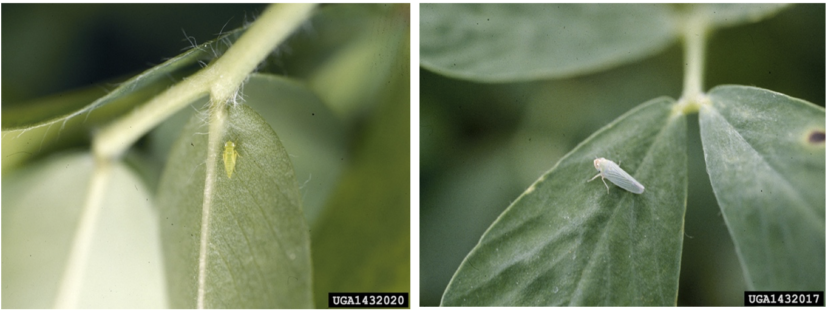
Figure 4. Potato leafhopper nymph (left) and adult (right). Image credit: Steve L. Brown, University of Georgia, Bugwood.org.
Blister Beetles
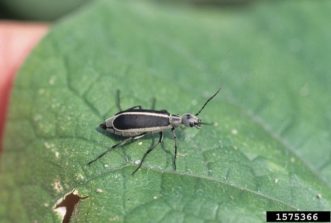
Figure 5. Margined blister beetle adult. Image credit: Gerald Holmes, Strawberry Center, Cal Poly San Luis Obispo, Bugwood.org.
Several species of blister beetles (Coleoptera: Meloidae) can be important in alfalfa in the southeastern United States, and those include the striped blister beetle, Epicauta vittata (Fabricius), the margined blister beetle, E. funebris Horn or E. pestifera Werner, the ashgray blister beetle, E. fabricii (LeConte), the black blister beetle, E. pennsylvanica (De Geer), and other species. Blister beetles have a thorax narrower than the head or elytra (outer protective wings) that do not extend to the tip of the abdomen. Common names are descriptive for adults. For example, the striped blister beetle has stripes on the dorsum running the length of the insect, and the margined blister beetle has light lines running around the margins of its dark elytra (figure 5). Although blister beetles are defoliators, damage is rarely economic. The major threat from blister beetles is the toxic chemical cantharidin produced internally by the insect that can be poisonous if consumed.13 Presence of blister beetles in cut hay contaminates the crop as feed for livestock, especially horses.13
Earlier cuttings of alfalfa are less at risk for being infested with blister beetles than later cuttings. Because blister beetles are attracted to flowering alfalfa, harvesting before or right after the beginning of bloom can lead to reduced incidence. Other recommendations include controlling broadleaf weeds (that may attract beetles), scouting to avoid harvesting areas of a field that are heavily infested, and minimizing damage from wheels that may crush beetles.14 Insecticides have been recommended when two beetles per square foot are found.9
Aphids
Although several species of aphids can be important in alfalfa in the region, the pea aphid, Acyrthosiphon pisum (Harris) (figure 6), and the spotted alfalfa aphid, Therioaphis maculata (Buckton) (figure 7), can infest the crop and severely stunt or kill young alfalfa plants. Identification of these species is easy, as aphids have distinctive characters. All aphids have a pair of structures called cornicles that resemble dual-exhaust tailpipes protruding near the tip of their abdomens, and antennae are usually very long on aphids. Another important characteristic is that aphids move slowly on plants as they walk around. The spotted alfalfa aphid is yellow to green and covered with spots. The pea aphid is larger than the spotted aphid, light green in color, and has very long and prominent antennae. Aphids have piercing-sucking mouthparts and feed on leaves. Symptoms of feeding are often characterized by yellowing of the foliage.
While research on economic thresholds is limited, forty aphids per stem (for plants less than fifteen inches tall) or between eighty to one hundred aphids per stem (for plants greater than fifteen inches tall) have been suggested.14 In addition to predators such as lady beetles, several parasitoid species (Aphidius ervi and Praon pequodorum) are widespread that can be effective in preventing aphids from exceeding thresholds.14,15
Armyworms
Defoliating caterpillars, such as larvae of the fall armyworm, the yellowstriped armyworm, and other species, can sometimes cause economic injury to forage crops. Because fall armyworm and other armyworm species are migratory, injury usually occurs later in the season. These species must move into our region from southern latitudes, so news of their “march” north often provides time to prepare for their impending presence. Armyworms are aptly named because they can feed as an “army” across fields of forage crops. Caterpillars of the fall armyworm have different color forms and can be light or dark brown or green. Larger caterpillars are slick/greasy/shiny in appearance and have a prominent upside-down letter ‘Y’ on their heads (figure 8). The chewing mouthparts of armyworms allow them to consume large quantities of leaf material, and defoliation can be swift.
Early cutting of alfalfa can be used as a cultural control practice.16 A threshold of two to three armyworms per square foot (any species) has been recommended for making insecticide applications.9
Grasshoppers

Figure 9. Two-striped grasshopper. Image credit: Whitney Cranshaw, Colorado State University, Bugwood.org.
A number of different grasshopper species can be pests of alfalfa. The differential grasshopper, Melanoplus differentialis (Thomas), and two-striped grasshopper, Melanoplus bivittatus (Say) (figure 9), are two of the most commonly reported species causing injury to alfalfa.17 Grasshoppers overwinter in the soil in the egg stage and produce one generation per year. Eggs are most commonly laid in undisturbed soils outside of crop fields in ditch banks or pastures at a depth of around two inches.18 Most adult grasshoppers are between three-fourths and two inches in length depending on the species and vary widely in color. Grasshoppers have enlarged hind legs, which are used for jumping. Nymphs are similar in appearance to adults but are smaller and lack fully developed wings. Significant outbreaks of grasshoppers are rare but are normally preceded by several hot and dry summers, which allow the population to grow slowly. When outbreaks do occur, defoliation can be severe and may warrant insecticide applications. An economic threshold of 10% defoliation or ten nymphs per square yard has been recommended.9 There are also non-chemical control strategies, such as broad tillage, that mechanically destroy grasshopper egg pods in the soil.
Although alfalfa alone is insufficient for grasshoppers to complete their development, a diet of alfalfa and suitable weeds in and around the field can support grasshopper populations.19 A weed control program in the field and limiting grassy weed hosts surrounding the field can reduce the population growth of grasshoppers. Discing or cultivating at-risk fields can also eliminate overwintering eggs and reduce populations.17,18 There is also some evidence that grasshopper resistant alfalfa varieties can be used to minimize damage and improve forage harvest.20
Over one hundred common bird species eat grasshoppers during all life stages, in addition to a number of beneficial insects, spiders, and mites that either directly feed upon or are parasites of grasshoppers.17 Grasshopper species have also been reported to be infected by parasitic nematode species in the genus Agamermis naturally in South Carolina, which can contribute to limiting grasshopper populations.21
Conclusions
This publication provides an overview of many of the important insect pests found in alfalfa in South Carolina and surrounding states. An IPM approach should be used to manage these pests, with chemical control used as a last resort. Updated recommendations on using insecticides in pastures, hay fields, and some forage crops, including alfalfa, are provided in the South Carolina Pest Management Handbook.
References Cited
- Summers CG. Integrated pest management in forage alfalfa. IPM Reviews. 1998;3:127–154. doi:10.1023/A:1009654901994.
- Blodgett SL, Lenssen AW, Cash SD. Harvest with raking for control of alfalfa weevil (Coleoptera: Curculionidae). Journal of Entomological Science. 2000;35(2):129–135. doi:10.18474/0749-8004-35.2.129.
- Kingsley PC, Bryan MD, Day WH, Burger TL, Dysart RJ, Schwalbe CP. Alfalfa weevil (Coleoptera: Curculionidae) biological control: spreading the benefits. Environmental Entomology. 1993;22(6):1234–1250. doi:10.1093/ee/22.6.1234.
- Radcliffe EB, Flanders KL. Biological control of alfalfa weevil in North America. IPM Reviews. 1998;3:225–242.
- Weintraub PG, Berlinger MJ. Physical control in greenhouses and field crops. In: Insect Pest Management. Berlin, Germany: Springer; 2004. p. 301–318.
- Harrington K, Carriere Y, Mostafa AM. Re-evaluating the economic injury level for alfalfa weevil (Coleoptera: Curculionidae) control in lowe desert irrigated alfalfa. Journal of Economic Entomology. 2021:1173–1179. doi:10.1093/jee/toab070.
- Ruppel RF. Diurnal sampling of the insect complex alfalfa. The Great Lakes Entomologist. 1974;7(4):113–116.
- Webster FM. The alfalfa weevil. Washington (DC): US Department of Agriculture Bureau of Entomology; 1911. Circular No. 137.
- Buntin DG. Alfalfa insect control. In: Cabrera E, Taylor M, editors. Georgia Pest Management Handbook: 2022 Commercial Edition. Vol. 2. UGA Extension Special Bulletin 28. Athens (GA): University of Georgia; 2022. p. 107–111.
- Beyer BA, Srinivasan R, Roberts PM, Abney MR. Biology and management of the threecornered alfalfa hopper (Hemiptera: Membracidae) in alfalfa, soybean, and peanut. Journal of Integrated Pest Management. 2017;8(1):1–10. doi:10.1093/jipm/pmx003.
- Shockley FW, Backus EA, Ellersieck MR, Johnson DW, McCaslin M. Glandular-haired alfalfa resistance to potato leafhopper (Homoptera: Cicadellidae) and hopperburn: development of resistance indices. Journal of Economic Entomology. 2002;95(2):437–447. doi:10.1603/0022-0493-95.2.437.
- Undersander D, Becker R, Cosgrove D, Cullen E, Doll J, Grau G, Kelling K, Rice ME, Schmitt MA. Alfalfa management guide. Madison (WI): American Society of Agronomy, Crop Science Society of America, Soil Science Society of America. Jointly published by University of Wisconsin-Extension, Cooperative Extension Minnesota Extension Service, University of Minnesota Iowa State University Cooperative Extension Service. 2004. NCR547 North Central Regional Extension Publication. https://www.nrcs.usda.gov/wps/PA_NRCSConsumption/download?cid=nrcseprd401854&ext=pdf.
- Capinera JL, Gardner DR, Stermitz FR. Cantharidin levels in blister beetles (Coleoptera: Meloidae) associated with alfalfa in Colorado. Journal of Economic Entomology. 1985;78(5):1052–1055. doi:10.1093/jee/78.5.1052.
- Hancock DW, Buntin GD, Ely LO, Lacy RC, Huesner GL, Stewart RL. Alfalfa management in Georgia. Athens (GA): University of Georgia Cooperative Extension; 2015 Jan. Bulletin 1350. https://secure.caes.uga.edu/extension/publications/files/pdf/B%201350_3.PDF.
- Angalet GW, Fuester R. The Aphidius parasites of the pea aphid Acyrthosiphon pisum in the eastern half of the United States. Annals of the Entomological Society of America. 1977;70(1):87–96. doi:10.1093/aesa/70.1.87.
- Knutson A, Bowling R, Corriher-Olson V. Managing insect and mite pests of Texas forage crops. College Station (TX): Texas A&M AgriLife Extension Service; 2017 Aug. ENTO-064. 31 p. https://extensionentomology.tamu.edu/resources/management-guides/managing-insect-pests-of-texas-forage-crops/.
- Webster FM. The grasshopper problem and alfalfa culture. Washington (DC): US Department of Agriculture, USDA Farmers’ Bulletin; 1915. FB637. p. 2–10.
- Severin HC, Gilberston GI. Destroy the grasshopper eggs. Brookings (SD): South Dakota Agricultural Experiment Station; 1931 Oct. Bulletin 267.
- Barnes OL. Food-plant tests with the differential grasshopper. Journal of Economic Entomology. 1963;56(3):396–399. doi:10.1093/jee/56.3.396.
- Harvey TL, Hackerott HL. Grasshopper-resistant alfalfa selected in the field. Environmental Entomology. 1976 Jun; 5(3):572–574.
- Stubbins FL, Agudelo P, Reay-Jones FPF, Greene JK. Agamermis (Nematoda: Mermithidae) infection in South Carolina agricultural pests. Journal of Nematology. 2016;48(4):290–296. doi:10.21307/jofnem-2017-037.

